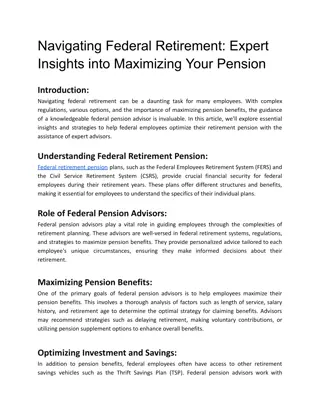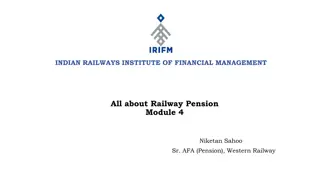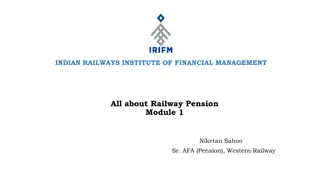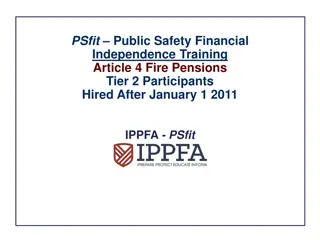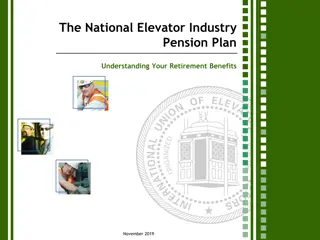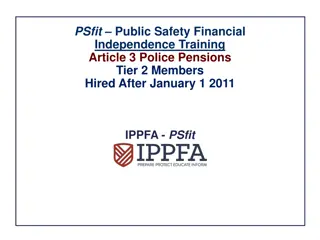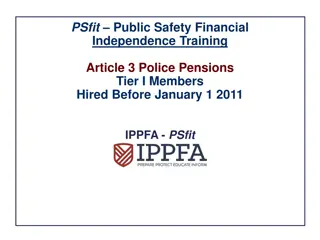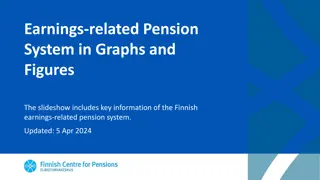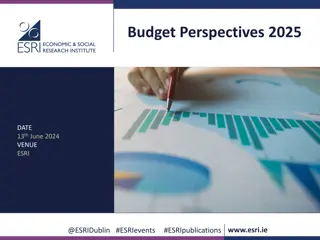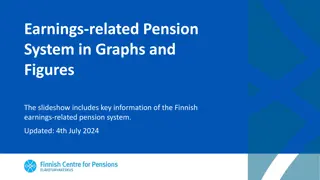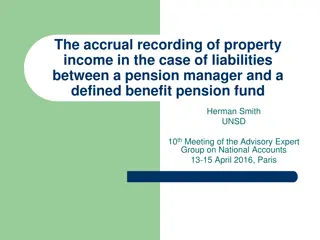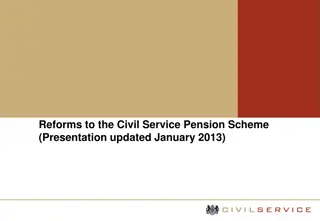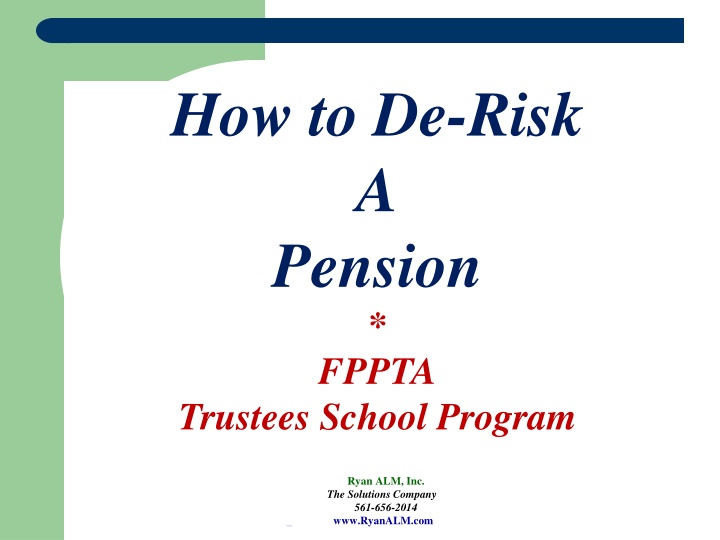
De-Risking Pension Strategies for FPPTA Trustees
Learn how to mitigate risks in pension management for FPPTA Trustees through effective strategies like benchmarking, liability indexing, and monitoring the funded ratio to ensure stability and low contribution costs. Addressing issues such as asset allocation, performance measurement, and accounting standards is key to achieving pension objectives.
Uploaded on | 0 Views
Download Presentation

Please find below an Image/Link to download the presentation.
The content on the website is provided AS IS for your information and personal use only. It may not be sold, licensed, or shared on other websites without obtaining consent from the author. If you encounter any issues during the download, it is possible that the publisher has removed the file from their server.
You are allowed to download the files provided on this website for personal or commercial use, subject to the condition that they are used lawfully. All files are the property of their respective owners.
The content on the website is provided AS IS for your information and personal use only. It may not be sold, licensed, or shared on other websites without obtaining consent from the author.
E N D
Presentation Transcript
How to De-Risk A Pension * FPPTA Trustees School Program Ryan ALM, Inc. The Solutions Company 561-656-2014 www.RyanALM.com
What is Risk? Sharpe (1966) Volatility of Returns Risk-free asset = 3 month T-Bill Ryan (1994) Uncertainty of meeting Objective Risk-free asset = matches objective
Pension Objective To fund liabilities such that contribution costs are low and stable over the future of active lives. To reduce risk over time.
Problem Liabilities are MIA in: Asset Allocation Asset Management Performance Measurement
Why? Actuarial Reports: Annual 6+ months delinquent No benefit payment schedule Actuarial valuation not market S&P 500?
Custom Liability Index Proper Benchmark Given projected benefit payments CLI calculates Monthly reports: PV (GASB 67 and AA Corporates) Interest Rate Sensitivity Growth Rate
Funded Ratio / Status Acid Test: FR = Assets / Liabilities FS = Assets Liabilities Critical: FR/FS have correct valuations FR/FS are updated frequently
Problem: Accounting GASB 25 Smoothed Fair Value (5 years) (Market Value) GASB 67 Assets Liabilities ROA ROA until assets exhausted (yield of 20-year muni) Error: 36% to 48% Moody s: AA corporates as discount rate
ROA Discount Rate for Liabilities Hurdle Rate for Assets ROA became Asset Allocation focus Instead of Funded Ratio/Status Pension Consultant
ROA Actuary Calculates Projected Contributions Actuary needs growth rate for A + L Assets + Liabilities = same growth rate Deficits erased only thru Contributions
Contributions Future Assets Predictable + Sizable Fund Liabilities Initially Excluded Funded Ratio / Status Included Asset Exhaustion Test Fiduciary Net Position (Assets Liabilities)
Problem : Asset Allocation Asset Allocation models used to validate ROA (Auditors) AA uses historical returns of asset classes (except Bonds = Yields) Lower rates trend reduced Bond allocation 1990s = Lowest Bond Allocation in history!
Solution: Responsive AA AA Based on Funded Ratio Surplus =/= Deficit Separate Beta + Alpha assets 130% = Beta 100%, Alpha 30% 60% = Beta 20%, Alpha 80%
Beta / Alpha Beta = Portfolio that matches Objective Alpha = Excess growth vs. Objective growth Requires CLI = to calculate Objective growth to create Beta Portfolio to measure Alpha
Objective: De-Risk Plan Liability Beta Portfolio Investment grade bond portfolio Cash flow matches benefit payments Chronologically or % of total At Lowest Cost Reduces Cost Reduces Risk (FR volatility) Buys time for Alpha assets to perform
De-Risk Plan Liability Beta Portfolio Cash Flow Matches Liabilities at Low Cost $1 million Liability Payment 5 year costs = $920,870 (YTM = 1.67%) 10 year = $787,690 (YTM = 2.41%) 20 year = $556,930 (YTM = 2.96%) 30 year = $398,090 (YTM = 3.13%)
Performance Measurement Total Asset vs. Total Liability Growth Measured frequently + accurately (quarterly + market values) Requires CLI to measure: Liability Growth Alpha Risk
Rates Go Up (5 Years) Liabilities = 3.00% >> 6.00% Growth Rate = ( 2.56%) Annual Note: Liabilities duration = 12 years Assets 5.0% 6.0% 7.0% Liabilities - 2.6% - 2.6% - 2.6% Alpha (Annual) 7.6% 8.6% 9.6% FR = 60% 88% 92% 97%
Recommended Guidelines 1. Install Custom Liability Index (CLI) 2. Install Liability Beta Portfolio (De-Risk) 3. AA respond to Funded Ratio/Status 4. Total Asset vs. Total Liability Growth


